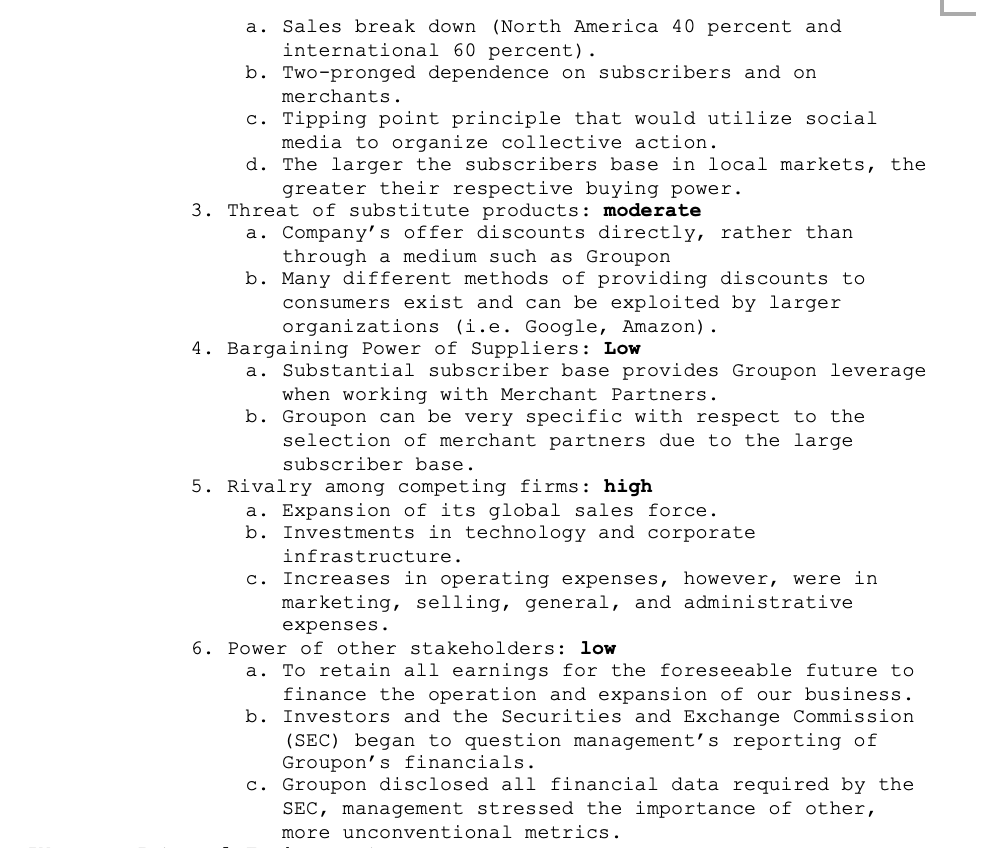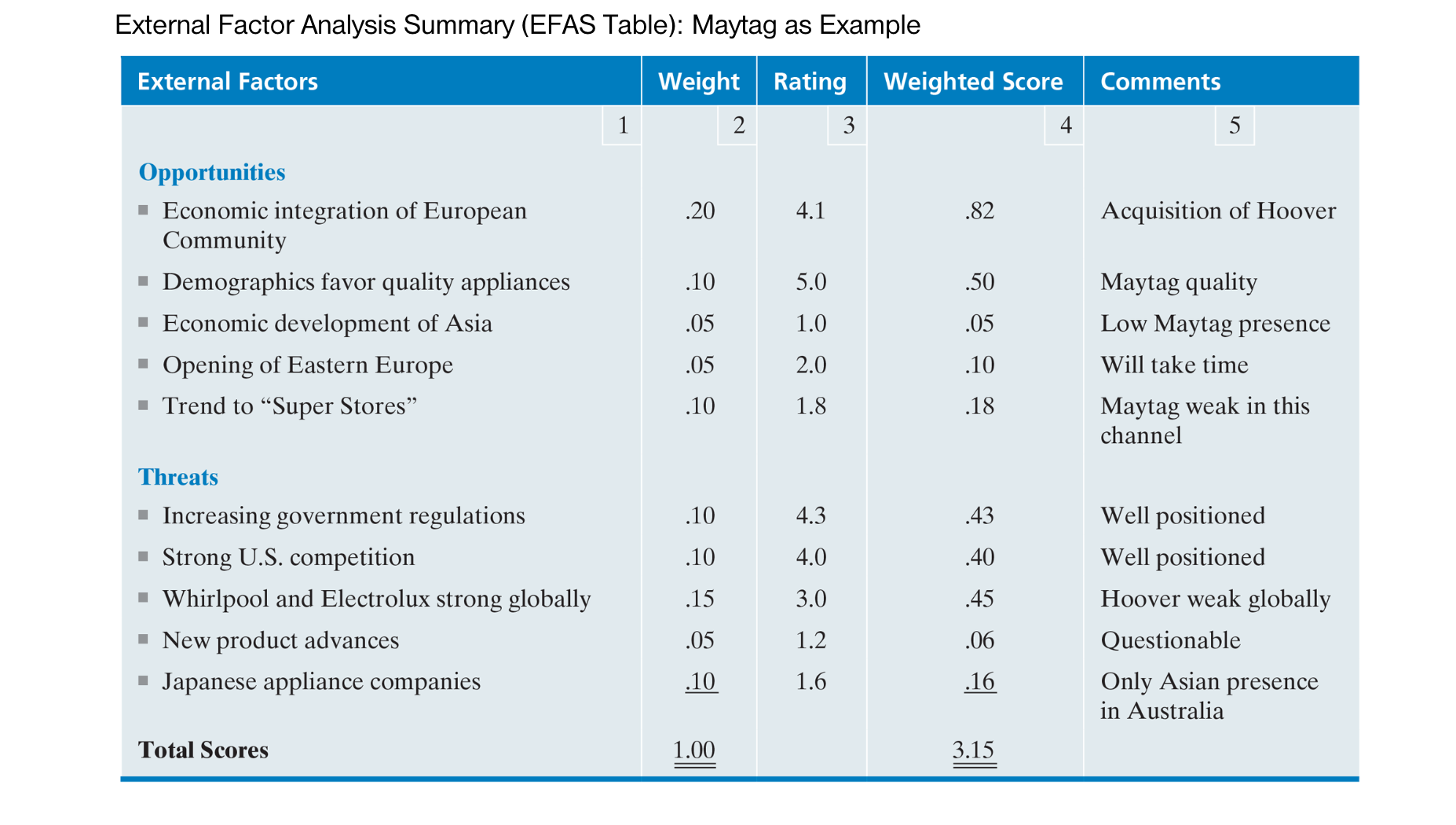Answered step by step
Verified Expert Solution
Question
1 Approved Answer
I made EFAS table but I'm uncertain on my answer. I would like to include expert's table on it as well. 1. Societal Environmental Analysis:
I made EFAS table but I'm uncertain on my answer. I would like to include expert's table on it as well.



 1. Societal Environmental Analysis: Identify key sociocultural, technological, economic, and political factors in the firm's external environment. 2. Industry Analysis: Use Porter's 5-forces model to accurately analyze competitive factors in the firm's industry (or industries) and assess the overall attractiveness of the industry (or industries). 3. External Factor Analysis Summary (EFAS): Summarize the external factors from your societal and industry analyses in an EFAS. b. Uncertain global economic conditions (T). c. The great recession and its slow recovery (T) d. Unfavorable foreign exchange rates (T). 2. Technological a. Communication technology constantly changing modes (O/T. b. Communication methods becoming increasingly inexpensive (O/T). c. Bringing the brick-and-mortar world of local commerce onto the Internet (O). d. First mover advantage-a web platform based on the "tipping point" principle. 3. Political and legal a. Consumer protection, marketing practices, tax and privacy rules and regulations (O/T). b. Evolving regulation of internet business, the credit Card Responsibility and Disclosure (CARD) Act of 2009 (N/A). c. The appearance of fee-splitting, kickbacks for referrals, and the ethics of using Groupons and other daily deals (O/T). d. Restatement of earnings in 2012 (T). e. Risk of litigation concerning intellectual property infringement suits, and suits by customers (N/A). f. Groupon had violated the patent, copyright, or trademark laws (T). 4. Sociocultural a. Increased availability of information pertaining to the prices of goods and services (O). b. More information conscious consumers, who are skilled at information gathering pertaining to purchases (O/T). c. Reduced loyalty toward "hometown" suppliers of goods and services if prices aren't competitive (0). d. Consumer behaviors regarding how they spend, shop, and think about discounts have changed dramatically. B. Task Environment 1. Threat of new entrants: high a. Significant revenue increases didn't go unnoticed by potential competitors. b. Business model easily replicated. c. Applicable in all global marketplaces. d. Start-up costs can be low if the initial market focus is small enough. 2. Bargaining power of buyers: high a. Sales break down (North America 40 percent and international 60 percent). b. Two-pronged dependence on subscribers and on merchants. c. Tipping point principle that would utilize social media to organize collective action. d. The larger the subscribers base in local markets, the greater their respective buying power. 3. Threat of substitute products: moderate a. Company's offer discounts directly, rather than through a medium such as Groupon b. Many different methods of providing discounts to consumers exist and can be exploited by larger organizations (i.e. Google, Amazon). 4. Bargaining Power of Suppliers: Low a. Substantial subscriber base provides Groupon leverage when working with Merchant Partners. b. Groupon can be very specific with respect to the selection of merchant partners due to the large subscriber base. 5. Rivalry among competing firms: high a. Expansion of its global sales force. b. Investments in technology and corporate infrastructure. c. Increases in operating expenses, however, were in marketing, selling, general, and administrative expenses. 6. Power of other stakeholders: low a. To retain all earnings for the foreseeable future to finance the operation and expansion of our business. b. Investors and the Securities and Exchange Commission (SEC) began to question management's reporting of Groupon's financials. c. Groupon disclosed all financial data required by the SEC, management stressed the importance of other, more unconventional metrics. External Factor Analysis Summary (EFAS Table): Maytag as Example
1. Societal Environmental Analysis: Identify key sociocultural, technological, economic, and political factors in the firm's external environment. 2. Industry Analysis: Use Porter's 5-forces model to accurately analyze competitive factors in the firm's industry (or industries) and assess the overall attractiveness of the industry (or industries). 3. External Factor Analysis Summary (EFAS): Summarize the external factors from your societal and industry analyses in an EFAS. b. Uncertain global economic conditions (T). c. The great recession and its slow recovery (T) d. Unfavorable foreign exchange rates (T). 2. Technological a. Communication technology constantly changing modes (O/T. b. Communication methods becoming increasingly inexpensive (O/T). c. Bringing the brick-and-mortar world of local commerce onto the Internet (O). d. First mover advantage-a web platform based on the "tipping point" principle. 3. Political and legal a. Consumer protection, marketing practices, tax and privacy rules and regulations (O/T). b. Evolving regulation of internet business, the credit Card Responsibility and Disclosure (CARD) Act of 2009 (N/A). c. The appearance of fee-splitting, kickbacks for referrals, and the ethics of using Groupons and other daily deals (O/T). d. Restatement of earnings in 2012 (T). e. Risk of litigation concerning intellectual property infringement suits, and suits by customers (N/A). f. Groupon had violated the patent, copyright, or trademark laws (T). 4. Sociocultural a. Increased availability of information pertaining to the prices of goods and services (O). b. More information conscious consumers, who are skilled at information gathering pertaining to purchases (O/T). c. Reduced loyalty toward "hometown" suppliers of goods and services if prices aren't competitive (0). d. Consumer behaviors regarding how they spend, shop, and think about discounts have changed dramatically. B. Task Environment 1. Threat of new entrants: high a. Significant revenue increases didn't go unnoticed by potential competitors. b. Business model easily replicated. c. Applicable in all global marketplaces. d. Start-up costs can be low if the initial market focus is small enough. 2. Bargaining power of buyers: high a. Sales break down (North America 40 percent and international 60 percent). b. Two-pronged dependence on subscribers and on merchants. c. Tipping point principle that would utilize social media to organize collective action. d. The larger the subscribers base in local markets, the greater their respective buying power. 3. Threat of substitute products: moderate a. Company's offer discounts directly, rather than through a medium such as Groupon b. Many different methods of providing discounts to consumers exist and can be exploited by larger organizations (i.e. Google, Amazon). 4. Bargaining Power of Suppliers: Low a. Substantial subscriber base provides Groupon leverage when working with Merchant Partners. b. Groupon can be very specific with respect to the selection of merchant partners due to the large subscriber base. 5. Rivalry among competing firms: high a. Expansion of its global sales force. b. Investments in technology and corporate infrastructure. c. Increases in operating expenses, however, were in marketing, selling, general, and administrative expenses. 6. Power of other stakeholders: low a. To retain all earnings for the foreseeable future to finance the operation and expansion of our business. b. Investors and the Securities and Exchange Commission (SEC) began to question management's reporting of Groupon's financials. c. Groupon disclosed all financial data required by the SEC, management stressed the importance of other, more unconventional metrics. External Factor Analysis Summary (EFAS Table): Maytag as Example Step by Step Solution
There are 3 Steps involved in it
Step: 1

Get Instant Access to Expert-Tailored Solutions
See step-by-step solutions with expert insights and AI powered tools for academic success
Step: 2

Step: 3

Ace Your Homework with AI
Get the answers you need in no time with our AI-driven, step-by-step assistance
Get Started


